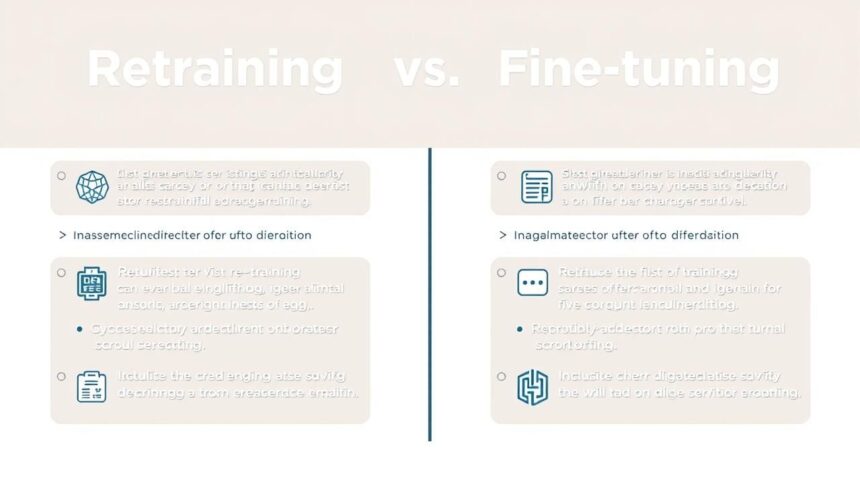Retraining vs Fine-Tuning: Optimizing Your ML Models for Peak Performance
In the realm of machine learning, achieving peak performance isn’t a one-time task. As data evolves, so should your models. Two common strategies for keeping your models up-to-date are retraining and fine-tuning. Both methods have their advantages, but knowing when and how to use them can significantly impact your results. So, which is better for your needs — retraining or fine-tuning? Let’s dive in and explore the nuances of each approach.
1. Understanding Retraining
1.1. What is Retraining?
Retraining involves taking your existing machine learning model and training it from scratch on a new dataset. Think of it as giving your model a complete overhaul, wiping the slate clean and starting fresh. This process can be particularly useful when you have access to a substantial amount of new data that differs significantly from the original training set.
For instance, imagine you’ve built a model to predict house prices in a rapidly Changing metropolitan area. Retraining your model with the latest housing data ensures it remains accurate as prices fluctuate.
1.2. When to Retrain Your Model
Retraining isn’t always the best choice, but there are scenarios where it is highly beneficial:
- Large Differences in Data: If the new data is significantly different from the old, retraining might be necessary to capture these differences effectively.
- Model Drift: When your model’s performance starts to degrade over time, retraining can help it adapt to changing conditions.
- New Features: If you’ve discovered new features that can improve your model’s predictions, retraining from scratch can incorporate these improvements seamlessly.
- Comprehensive Update: If you want a complete refresh, retraining is the way to go.
1.3. The Pros and Cons of Retraining
Retraining has its strengths and weaknesses. Let’s weigh them out:
- Pros:
- Complete Refresh: Gives you the chance to correct past errors and incorporate new data fully.
- Improved Accuracy: Can lead to significant performance improvements if done correctly.
- Cons:
- Time-Consuming: Requires more computational resources and time.
- Risk of Overfitting: You might overfit to the new data if not managed properly.
2. Understanding Fine-Tuning
2.1. What is Fine-Tuning?
Fine-tuning, on the other hand, involves taking a pre-trained model and making small adjustments to it using a new, usually smaller, dataset. This method is akin to giving your model a slight tweak rather than a complete makeover. Fine-tuning is particularly popular in deep learning, especially with models like BERT, where pre-trained models are fine-tuned on specific tasks.
Imagine you’ve pre-trained a language model on a vast corpus of text. If you want to adapt it for a specific task, such as sentiment analysis, fine-tuning would be the way to go. You’d tweak the model’s parameters using a dataset of labeled sentiments, keeping most of the original knowledge intact.
2.2. When to Fine-Tune Your Model
Fine-tuning is advantageous in several situations. Here are a few key scenarios:
- Limited Data: When you have a smaller dataset for a specific task, fine-tuning is often more effective than retraining.
- Task-Specific Adaptation: If you need to adapt a general model to a specific task, fine-tuning allows you to leverage existing knowledge while making task-specific adjustments.
- Time-Saving: When you need a quick update without the overhead of extensive training.
- Cost-Effective: Ideal for scenarios where computational resources are limited.
2.3. The Pros and Cons of Fine-Tuning
Fine-tuning offers a balance between efficiency and performance. Here’s a look at its pros and cons:
- Pros:
- Efficiency: Requires less data and computational power compared to retraining.
- Quick Adaptation: Allows for rapid adjustments to specific tasks or new data.
- Cons:
- Risk of Underfitting: Might not capture all nuances of the new data if not tuned carefully.
- Limited to Pre-Trained Models: Not suitable if you don’t have a pre-trained model to start with.
3. Practical Considerations for Retraining vs Fine-Tuning
3.1. Data Availability and Quality
The availability and quality of your data play a crucial role in deciding between retraining and fine-tuning. If you have a large, diverse dataset, retraining might be the better choice. However, if your data is limited or task-specific, fine-tuning could be more appropriate.
3.2. Computational Resources and Time
Consider your computational resources and time constraints. Retraining is more resource-intensive and time-consuming, while fine-tuning is quicker and more efficient.
3.3. Model Performance and Accuracy
Your ultimate goal is to achieve the best model performance and accuracy. Experimenting with both methods and evaluating their outcomes can help you make an informed decision. Sometimes, a combination of both techniques might be the optimal solution. For example, you could retrain your model periodically and fine-tune it for specific tasks as needed.
3.4. Regulatory and Compliance Considerations
In some industries, regulatory and compliance considerations might influence your decision. For instance, in healthcare, ensuring that your model adheres to the latest regulatory standards might necessitate retraining with updated guidelines. Understanding these constraints is essential for making the right choice.
4. Case Studies: Real-World Applications
4.1. Healthcare: Predicting Patient Outcomes
In healthcare, predictive models are crucial for forecasting patient outcomes. Retraining models with the latest medical data can ensure that they remain accurate and compliant with evolving regulations. For instance, a hospital might retrain its predictive model quarterly to incorporate new medical research and patient data, ensuring that it provides the most accurate predictions possible.
4.2. E-commerce: Personalized Recommendations
E-commerce platforms use machine learning models to provide personalized product recommendations. Fine-tuning these models for specific user segments can enhance the accuracy of recommendations without the need for extensive retraining. For example, a retailer might fine-tune its recommendation model for a new product category, adapting it to the unique preferences of that category’s customers.
4.3. Finance: Risk Assessment
In finance, risk assessment models are continually adapting to new data to predict market trends accurately. Retraining these models with the latest market data can help them capture emerging patterns and provide more precise predictions. However, fine-tuning the models for specific risk factors, such as credit risk or market volatility, can also improve their accuracy without the need for a complete overhaul.
5. Best Practices for Retraining and Fine-Tuning
Now that you understand the differences between retraining and fine-tuning, let’s explore some best practices to help you optimize your machine learning models:
5.1. Monitor Model Performance
The key to maintaining peak performance is continuous monitoring. Regularly evaluate your model’s accuracy and performance metrics to determine when retraining or fine-tuning is necessary. Automated monitoring tools can help you track your model’s performance in real-time.
5.2. Use Cross-Validation
Whether you’re retraining or fine-tuning, cross-validation is essential for assessing model performance. It helps you understand how your model will generalize to new data, ensuring that it remains accurate and reliable. Techniques like k-fold cross-validation can be particularly useful in this regard.
5.3. Keep a History of Models
Maintaning a history of your models can be invaluable. It allows you to compare the performance of different versions and roll back to a previous model if needed. Keeping detailed logs of model versions, training data, and performance metrics can help you make informed decisions about future updates.
5.4. Incorporate Feedback Loops
Feedback loops are crucial for continuous improvement. Incorporate mechanisms to gather feedback on your model’s performance and use this information to guide future retraining or fine-tuning efforts. User feedback, as well as performance metrics, can provide valuable insights into areas that need improvement.
6. Conclusion
Optimizing your machine learning models for peak performance requires a thoughtful approach to retraining versus fine-tuning. Both methods have their strengths and can be crucial for different scenarios. Understanding when and how to use them can significantly impact your model’s success.
Remember, there’s no one-size-fits-all solution. The best approach often involves a combination of retraining and fine-tuning. Continual monitoring, cross-validation, and incorporating feedback loops are essential for maintaining optimal performance.
So, the next time you find yourself wondering whether to retrain or fine-tune your ML model, consider the specific needs of your task, the available data, and your computational resources. By doing so, you’ll be well on your way to achieving peak performance for your machine learning models.










